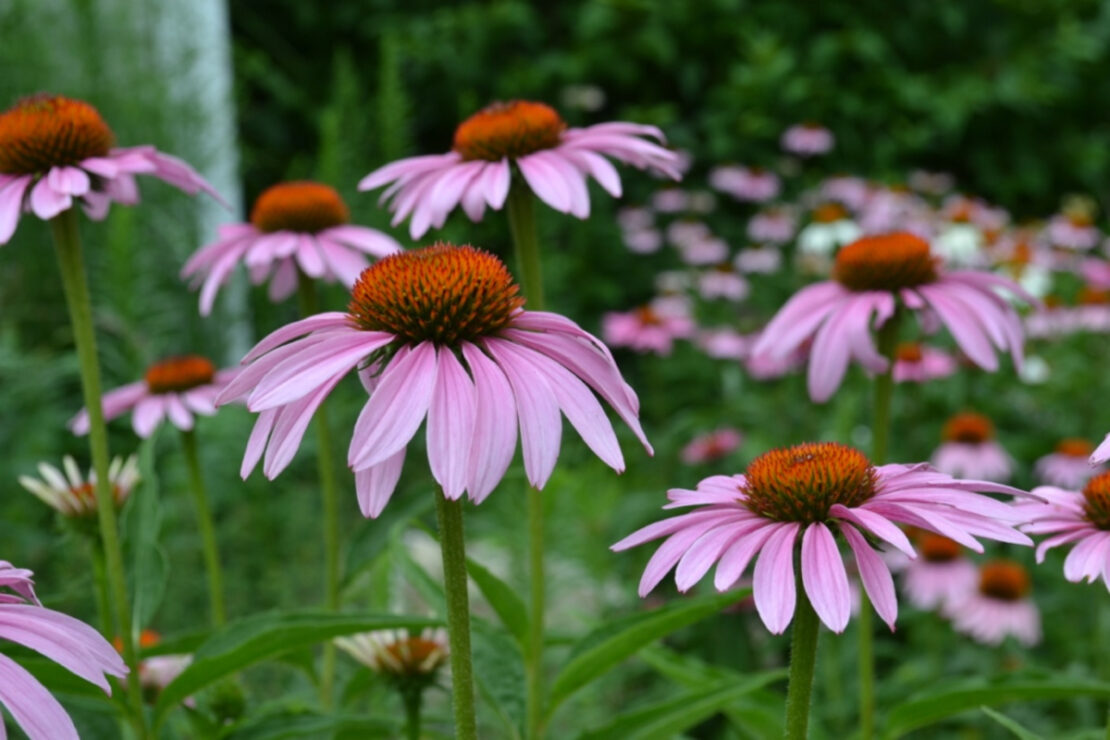
Echinacea and Goldenseal: When to Use One Over the Other
Echinacea (Echinacea spp.) and goldenseal (Hydrastis canadensis) are popular herbal allies during cold and flu season. These plants can help cope with cold and flu symptoms and aid the body in its recovery process. Both echinacea and goldenseal have antibacterial properties; however, understanding them in this narrow context doesn’t fully inform their whole range of applications, or zero in on what these two herbs do best!
Destruction of habitat and overharvesting has landed both echinacea and goldenseal on the United Plant Savers At-Risk list (United Plant Savers, 2018). The United States Department of Agriculture (USDA) reports that both plants are on federal and/or state threatened and/or endangered lists (USDA, n.d.). Based on the current status of these plants, there are important ethical considerations surrounding the use and sourcing of these plant materials and extracts.
In this post, we’ll offer guidance about the best times to use echinacea and goldenseal, along with more sustainable replacement options for each.
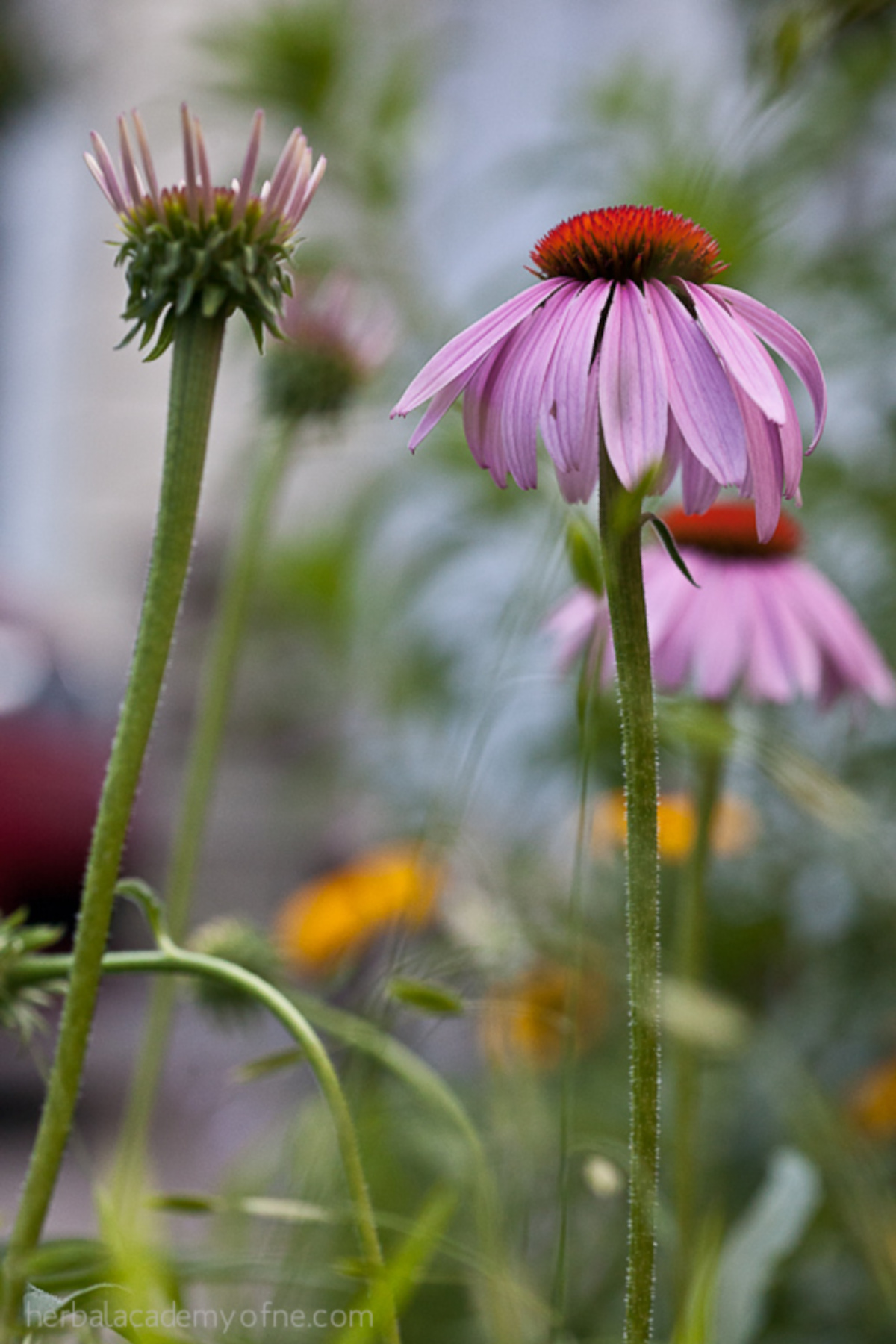
Echinacea (Echinacea spp.) root, flower head, and leaf
Information about how to use echinacea comes from many Native American tribes. The Lakota people, for example, have a traditional use of making a poultice from the root of E. angustifolia and applying the poultice to wounds, burns, and venomous bites, and using a decoction or tincture of the roots for supporting the immune system and easing cold and flu symptoms, such as sore throat (Black Elk & Flying By, 1998). The Cheyenne have a traditional use of E. pallida, chewing on the root for toothaches and colds, drinking a tea of roots and leaves for sore throat, and applying a decoction of the root externally to cool fevers and burns (Bernier, 2004).
Echinacea is most popularly used in the hopes of allaying symptoms and shortening the duration of a cold or the flu (Chevallier, 2016). Double-blind studies have shown that echinacea extract may reduce the symptoms of a cold, and that taking an echinacea extract at the very first inkling of a cold may shorten its duration (Bastyr University Department of Botanical Medicine, 2003). Echinacea does contain antibacterial components, but its primary action is as an immunostimulant, which is why it is recommended that you use echinacea at the first sign of symptoms (Bone, 1997).
Echinacea contains a constituent called cichoric acid; this compound has been shown to stimulate phagocytosis in living organisms (Bone, 1997). Phagocytosis is the process by which specific cells in the body consume and neutralize bacteria. The increased ability to neutralize harmful intruders makes echinacea the go-to choice in the very onset of symptoms, or if you’ve recently shared germs with someone who is ill.
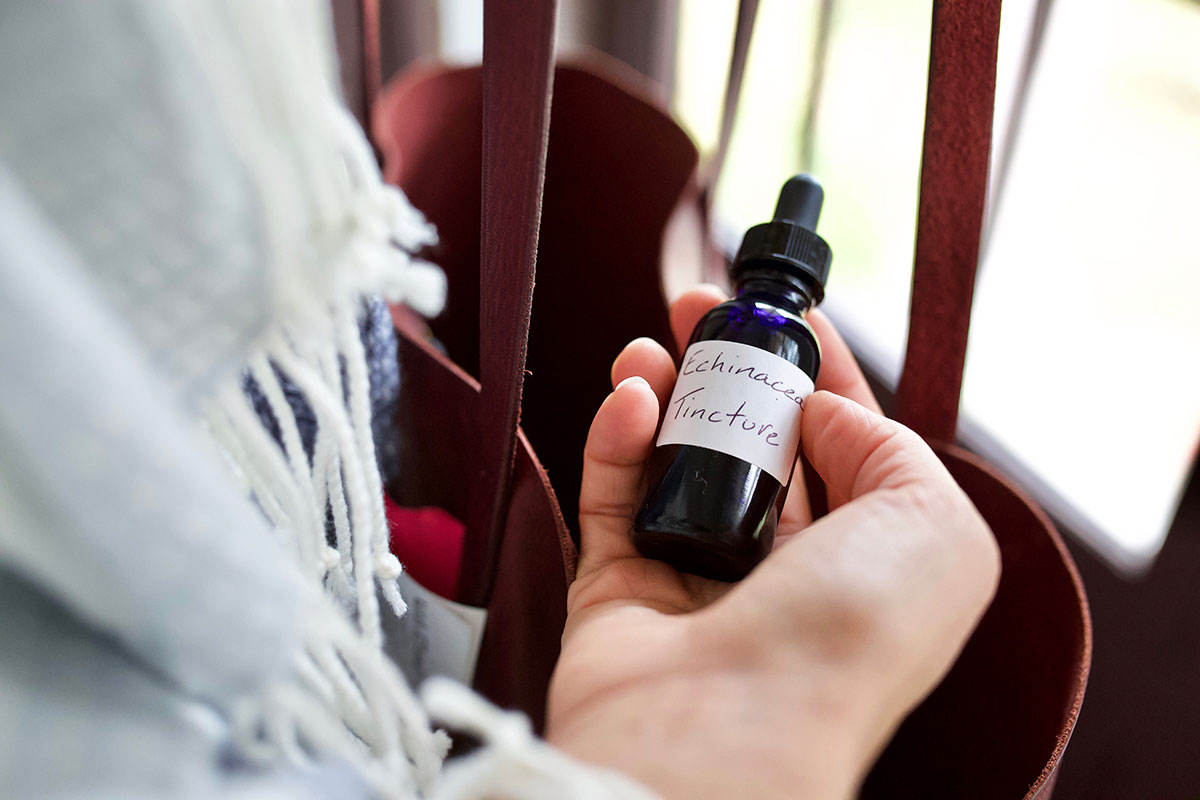
Choose an echinacea extract or tincture over the powdered root. Certain constituents in the roots are prone to oxidation and will deteriorate rapidly once the plant material has been broken down (Bone, 1997). An echinacea tincture made with 50% alcohol and a plant to solution ratio of at least 1:5 is a good choice (Green, 2002). Preparations of E. purpurea and E. angustifolia should leave a tingling numbness in the mouth. Adults can generally take 2 mL doses (1:5, 55%) of tincture 3x/day, as needed, for up to 10 days, for the most common uses (ESCOP, 2019; Mount Sinai,n.d.).
Another option for those with access to fresh echinacea is to juice the aerial portion of the plant. Several studies show that a fresh juice of the aerial parts of E. purpurea acts on the non-specific cellular immune system. One randomized, double-blind, placebo-controlled study conducted showed that participants with initial signs of a cold who were given a fresh juice of the aerial parts of echinacea, preserved in 22% alcohol by volume, were less likely to develop full symptoms and recovered in half the time as patients who were not given the echinacea preparation (American Botanical Council, 2000). Using the aboveground portion of the plant is more sustainable than using the roots, since the life of a plant is not shortened by the harvest of the tops.
Some people with allergies to members of the Asteraceae family could have an allergic reaction to echinacea products. There is some theoretical concern about the use of echinacea by people with chronic infections, autoimmune disorders, or organ transplants (Mount Sinai, n.d.). (Learn more in Safe Antiviral Herbs for Autoimmune Disease.) Consult an herbalist trained in the pediatric use of herbs prior to use with children (Sinai, n.d.).
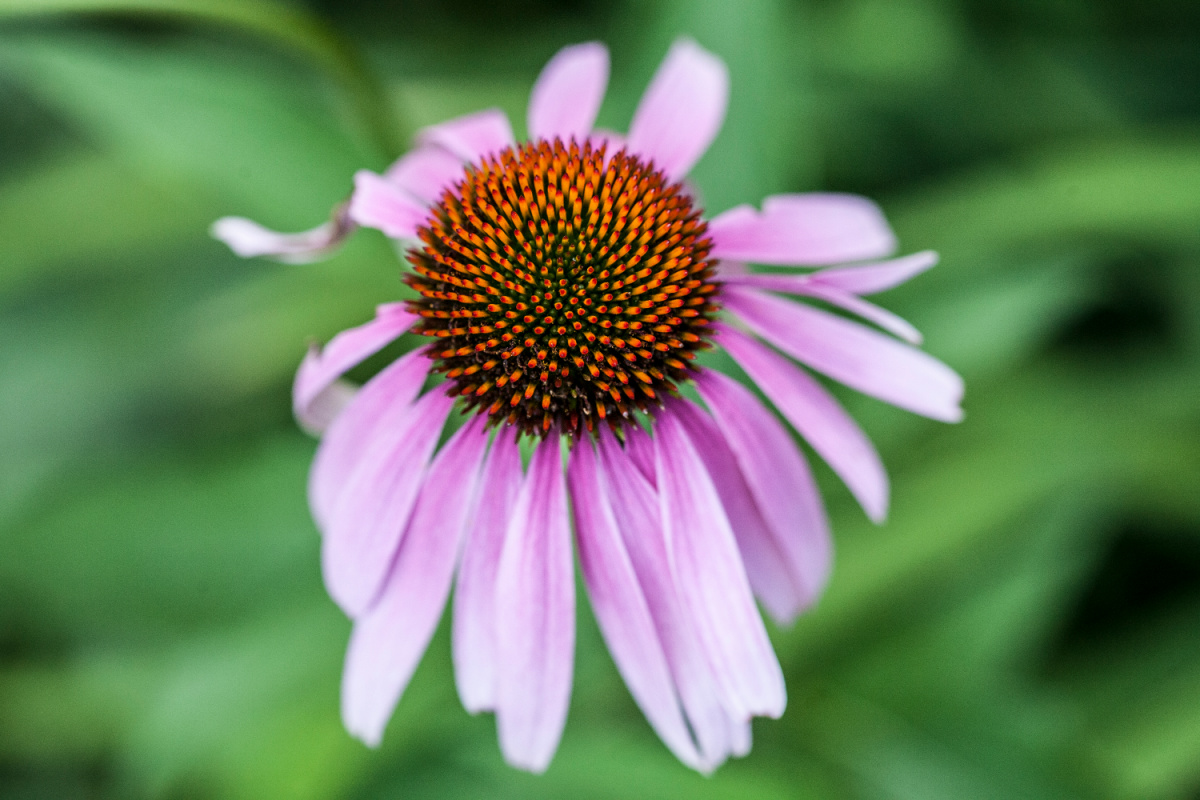
Echinacea’s Sustainability Concerns and Replacements
Habitat destruction, as well as intensive harvests due to the plant’s popularity, has put a strain on wild echinacea populations. If you purchase herbal supplements, choose from companies who source echinacea from sustainable organic farms, rather than wild plant stands. Fortunately, cultivated sources of echinacea are widely available due to the widespread demand for this scarce herb (Brinker, 2013).
A potent substitute for echinacea is spilanthes (Acmella oleracea), another member of the Asteraceae family. This is a tropical plant that can be grown as an annual in many climates. Spilanthes, like echinacea, contains alkamides, which are responsible for the tingly numbness experienced when the herb is ingested. In fact, you will experience that sensation to a far greater extent with spilanthes than with echinacea. Spilanthes may also help regulate the body’s immune response and contains antibacterial components (Dubey et al., 2013). Traditional preparations use the aerial portions of this plant, making it a much more sustainable plant to harvest and use.
Choose an organic spilanthes supplement. For tinctures, adults can take 1mL (1:5, 40%) up to 5/per day (Bastyr University Department of Botanical Medicine, 2003). It has no known contraindications, although it may have the potential to irritate those with allergies to the Asteraceae family.
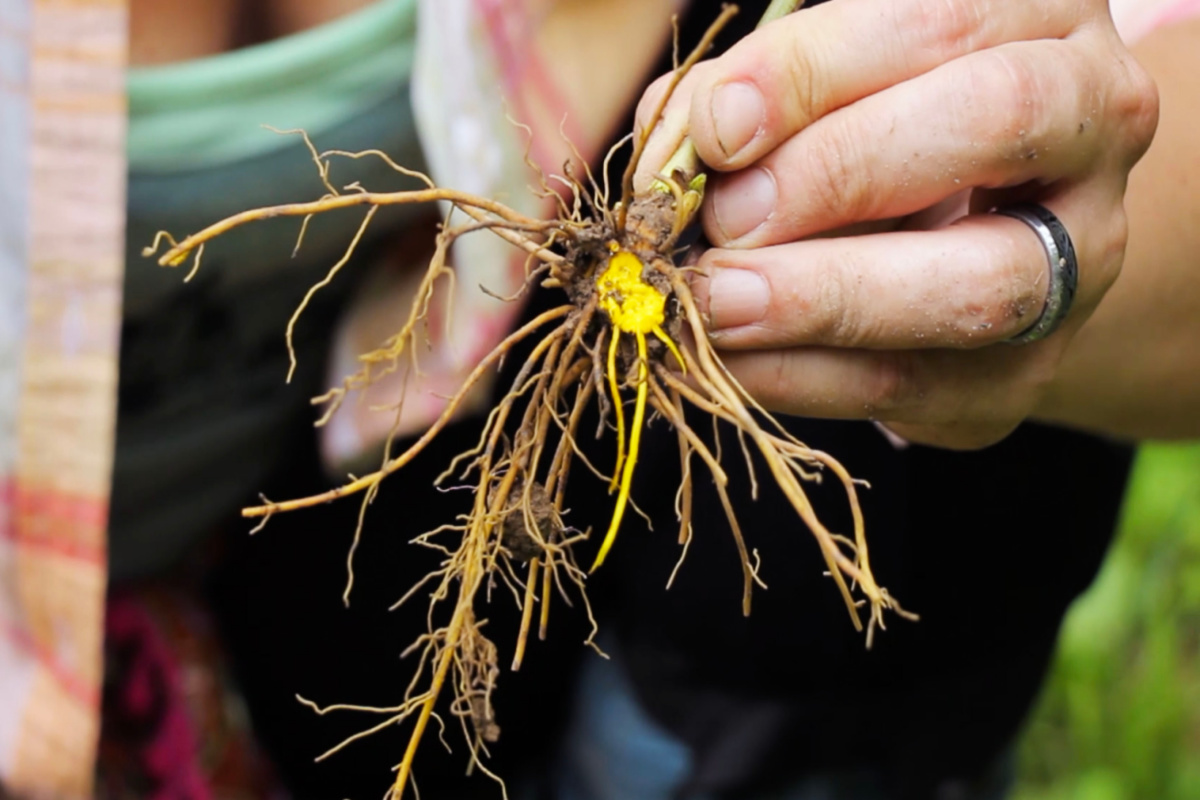
Goldenseal (Hydrastis canadensis) root
American physicians adopted the use of goldenseal (Hydrastis canadensis) root in the mid-1800s, but Native Americans were using it long before. John D. Hunter was raised by members of the Kickapoo nation and wrote that this herb was used for edema and sore eyes (Hunter, 1823). The Cherokee have a traditional use of goldenseal as a wash for cleaning cuts and wounds. It is also used as an eye wash and for treating mouth sores (Garrett, 2003).
Like echinacea, goldenseal’s application has been misconstrued throughout the years. Paul Bergner, Director of the North American Institute for Medical Herbalism, says that in his experience both from retail and clinical work the vast majority of goldenseal sold and purchased is misused by consumers (Bergner, 1997). The misuse of this herb contributes to the already compromised vitality of its wild populations.
Part of this misconception is associated with the common focus on the antibacterial properties of the constituent berberine in goldenseal roots.
The concentration of berberine that we can absorb through our intestines into our bloodstream isn’t really comparable to the concentration that is effective against pathogens in in vitro studies. This suggests berberine itself is not acting as a systemic antibiotic, at least not in the same way as pharmaceutical antibiotics. It may be that additional constituents and actions help when goldenseal or similarly used plants are applied topically or used for respiratory or gastrointestinal (GI) use. (Bergner, 1997)
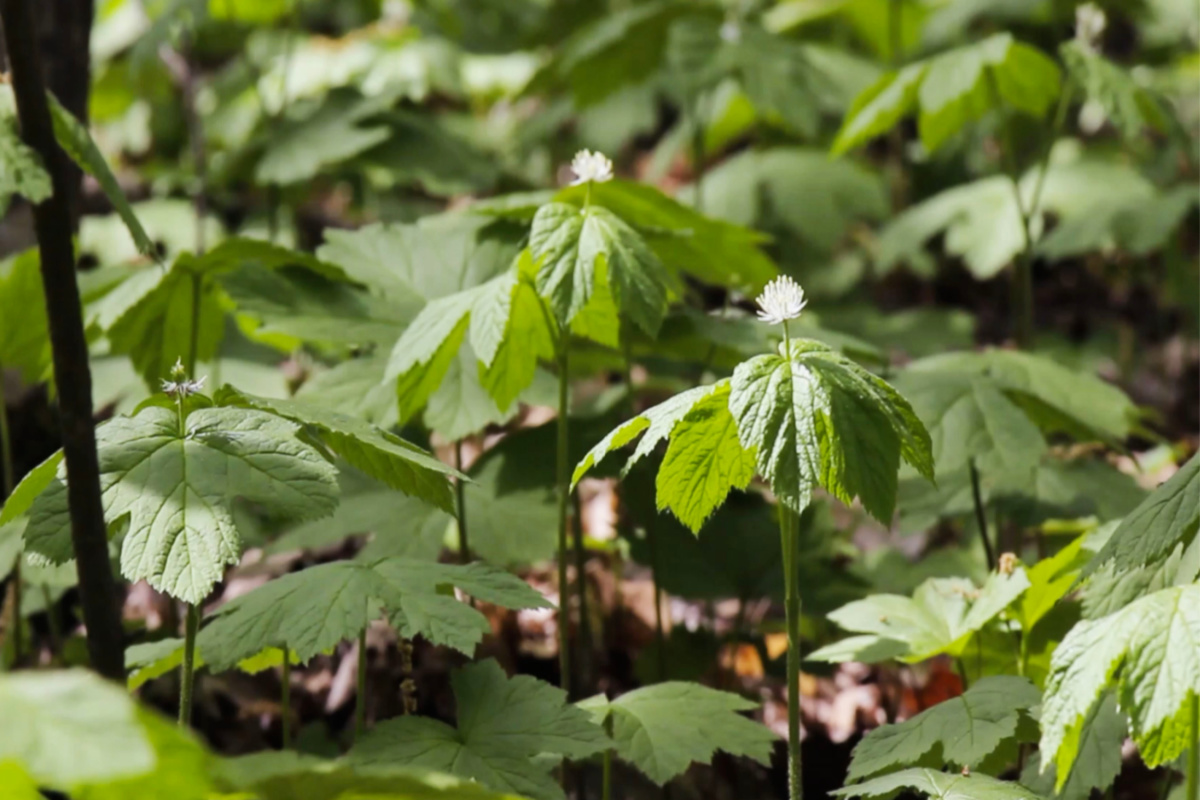
It is a widely held belief that if we have a cold or flu we need antibiotics. Presuming that the primary benefit of goldenseal is its antibiotic action leads many to use this herb at much too high a dose and at the wrong stage of infection (Bergner, 1997). When plagued with upper respiratory infections, the greatest gift of goldenseal is the ability to assist in moving stagnant mucus. Stimulating the production of mucus by the body’s mucosal linings, goldenseal assists with the disbursement of congestion and cleansing of tissues (Bergner, 1997; Hobbs, 1998).
Whether or not we benefit from an antibiotic property of berberine, berberine-rich plants have traditional use as mucosal membrane tonics, helping the protective functions of the secretions of the mouth, throat, stomach, GI tract, and even respiratory tract. To an extent you might even feel this effect immediately in your sinuses or throat when you are congested, or your throat is raw or irritated, whether from coughing, allergies, or prolonged sinus drainage, after tasting a berberine-containing plant.
Unlike echinacea, goldenseal may not be as helpful during the first few days of infection when the body is in the initial stages of an immune response. At this stage, the body will already be producing excess mucus as part of the initial inflammatory response and in an effort to fight off disease. Goldenseal is best when inflammation and stagnation of mucus in the sinuses are persistent, lasting longer than a few days. In these cases, goldenseal helps to move heat and cool excess inflammation (Hobbs, 1998).
When taken in larger doses and for longer periods, this herb has the potential to dry out the mucosal membranes. The drying effect occurs because this plant stimulates the body to use its moisture in mucosal production, which ultimately leads to the depletion of moisture in the body (Bergner, 1997).
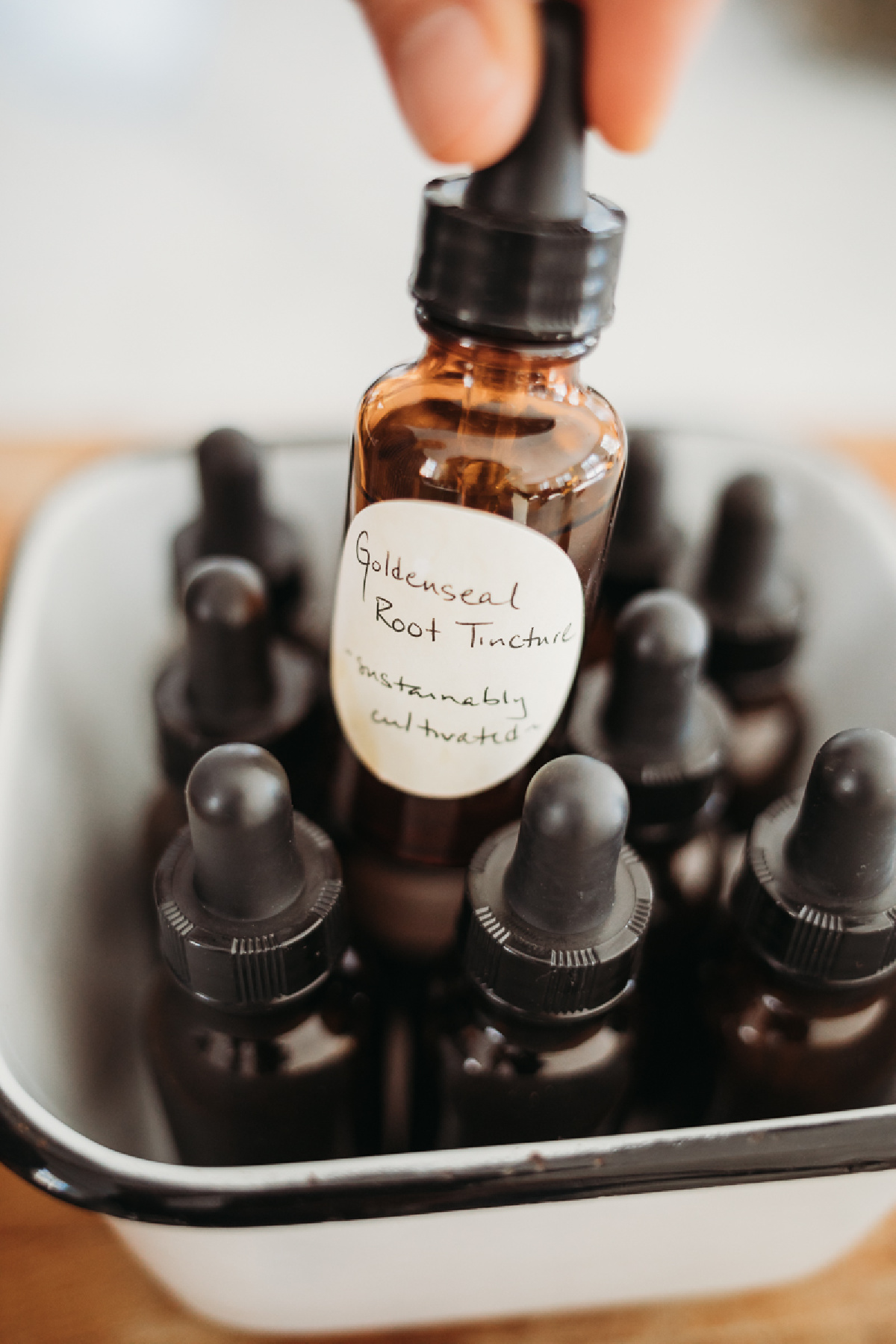
Buying and Using Goldenseal
When purchasing goldenseal, choose products made from organically cultivated plants, never wildcrafted (keep reading for a sustainable replacement option for goldenseal). Powdered root supplements have seen some popularity, but tinctures’ extended shelf life makes them a better choice. For adults take 1 ml (1:5, 60%) 3x/day for no longer than a week (Hoffman, 2003).
Those who are pregnant or nursing should consult their healthcare professional before using goldenseal. People with high blood pressure, liver, or heart disease should consult a physician before using goldenseal. Hydrastis may interfere with certain medications and their effects (Pengelly et al., 2012). Those taking prescription drugs should consult a healthcare practitioner with an understanding of drug and herb interactions before use.
Oregon Grape Root: A More Sustainable Replacement for Goldenseal
Like goldenseal, Oregon grape (Berberis aquifolium) root also contains berberine and has an effect on the mucosa. The similarities in constituency, energetics, and actions make Oregon grape root an adequate substitute for goldenseal root, especially when addressing upper respiratory conditions. It would be similarly employed, and, like goldenseal, it’s best used in instances of stagnant mucus and inflammation (“Materia Medica Monthly – Vol 7,” 2016).
Contraindications and recommendations for when to seek the guidance of a medical professional are similar to those listed above for goldenseal (Materia Medica Monthly – Vol 7,” 2016). Choosing Oregon grape root over goldenseal puts less stress on goldenseal populations, and is also more cost-effective. (Oregon grape root tinctures are about half the investment of goldenseal tinctures.)
Oregon grape root is not on United Plant Savers’ “At-Risk” list like echinacea and goldenseal are. However, it is on their “to-watch” list, which means we still need to source and use it wisely. Find a company that is making their tincture with ethically wildcrafted or, even better, organically cultivated roots. The best way to find out about the qualifications and standards a company has for ethical wildcrafting is to call and ask.
The adult dosage for Oregon grape root tincture is 1-4 ml (1:5, 40%) three times a day (Hoffmann, 2003). Like goldenseal, Oregon grape root can have a drying effect on the tissues with long term use (Materia Medica Monthly – Vol 7,” 2016).
In Closing,
Echinacea and goldenseal are both valuable plant allies that are best honored by an understanding of when and how to use them. By using them correctly, making ethical choices in the sourcing of their plant materials or extracts, and using appropriate substitutions, we can all contribute to the conservation of these herbal gifts and benefit from them for our wellness. Our allies need our allyship.
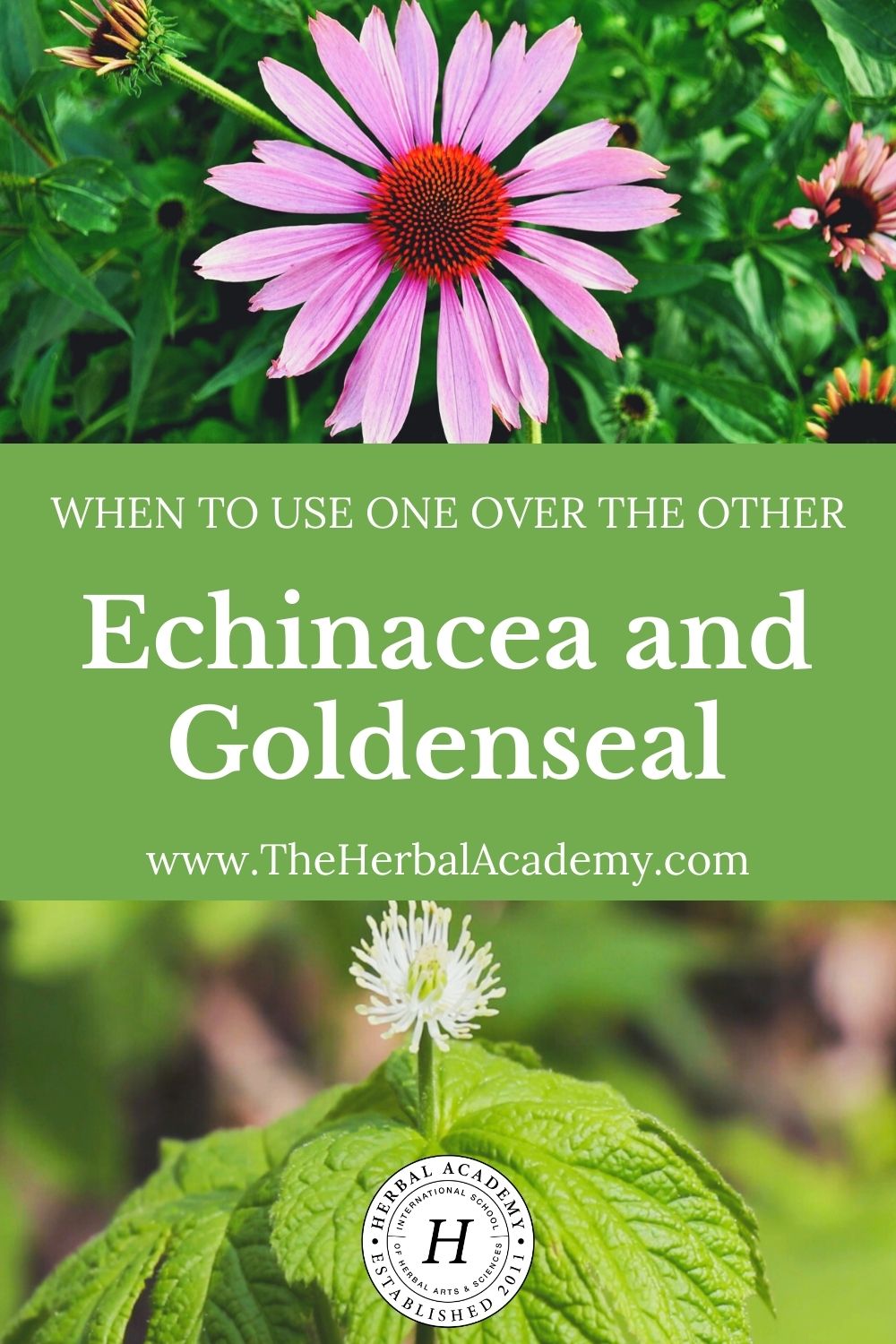
REFERENCES
American Botanical Council. (2000). Echinacea purpurea root. In Herbal Medicine: Expanded Commission E. Retrieved from http://cms.herbalgram.org/expandedE/EchinaceaPurpurearoot.html
American Botanical Council. (2003). Goldenseal. In The ABC Clinical Guide to Herbs. Retrieved from http://cms.herbalgram.org/ABCGuide/GuidePDFs/Goldenseal.pdf
Bastyr University Department of Botanical Medicine (2003). Bastyr materia medica [PDF]. Retrieved from http://docshare02.docshare.tips/files/21346/213462978.pdf
Bergner, P. (1997). Goldenseal and the common cold: The antibiotic myth. Medical Herbalism: A Journal for the Clinical Practitioner, Volume 8 (number 4) Retrieved from http://www.medherb.com/84.HTM
Bernier, G.R. (2004). Ethnobotany of the Northern Cheyenne: Medicinal plants [Graduate Student Dissertation]. Retrieved from https://scholarworks.umt.edu/cgi/viewcontent.cgi?article=10335&context=etd
Black Elk, L.S., & Flying By, W.D. (1998). Culturally important plants of the Lakota [PDF]. Retrieved from https://puc.sd.gov/commission/dockets/HydrocarbonPipeline/2014/HP14-001/testimony/betest.pdf
Bone, K. (1997). Echinacea: What makes it work? [PDF]. http://www.anaturalhealingcenter.com/documents/Thorne/articles/Echinaeca.pdf
Brinker, F. (2013). Echinacea differences matter: Traditional uses of Echinacea angustifolia root extracts vs. modern clinical trials with Echinacea purpurea fresh plant extracts. HerbalGram, 97, 46-57. Retrieved from http://cms.herbalgram.org/herbalgram/issue97/hg97-feat-echinacea.html?ts=1601388850
Chevallier, A. (2016). Encyclopedia of herbal medicine. New York, NY: Dorling Kindersley Limited.
Dubey, S., Maity, S., Singh, M., Saraf, S. A., & Saha, S. (2013). Phytochemistry, pharmacology and toxicology of Spilanthes acmella: A review. Advances in Pharmacological Sciences, 2013, 423750. https://doi.org/10.1155/2013/423750
ESCOP. (2019). Echinacea angustifoliae radix: Narrow-leaved coneflower root [PDF]. Retrieved from https://escop.com/wp-content/uploads/edd/2019/03/Echinacea-angustifolia-ESCOP-2019.pdf
Green, J. (2002). The herbal medicine-makers’ handbook: A home manual. Berkeley, CA: Crossing Press.
Hobbs, C. (1998). Echinacea and goldenseal: the dynamic duo. [Article] Retrieved from https://www.christopherhobbs.com/library/articles-on-herbs-and-health/echinacea-and-goldenseal-the-dynamic-duo/
Hoffmann, D. (2003). Medical herbalism: the science and practice of herbal medicine. Rochester, VT: Healing Arts Press.
Hunter, J.D. (1928). Memoirs of a captivity among the Indians of North America, from childhood to the age of nineteen, with anecdotes descriptive of their manners and customs. to which is added, some account of the soil, climate and vegetable productions of the territory westward of the Mississippi. Retrieved from https://play.google.com/books/reader?id=dhLSAAAAMAAJ.
Mount Sinai. (n.d.) Echinacea. Retrieved from https://www.mountsinai.org/health-library/herb/echinacea
Pengelly, A., Bennett, K., Spelman, K., & Trims, M. (2012). An Appalachian plant monograph goldenseal Hydrastis canadensis L. Retrieved from https://www.researchgate.net/publication/236659731_An_Appalachian_Plant_Monograph_Goldenseal_Hydrastis_canadensis_L
Setzer, W.N. (2018). The phytochemistry of Cherokee aromatic medicinal plants. Medicines, 5(4). https://doi.org/10.3390/medicines5040121
The School of Evolutionary Herbalism. (n.d.). Materia Medica Monthly – Vol 7 : Oregon Grape (Mahonia spp.). Retrieved from https://www.evolutionaryherbalism.com/wp-content/uploads/2016/10/Oregon-Grape-Mahonia-aquifolium.pdf
United States Department of Agriculture. (n.d.). Threatened & endangered [Database]. Retrieved from https://plants.usda.gov/threat.html
United Plant Savers (2018). Species at-risk list. [Database]. Retrieved from https://unitedplantsavers.org/species-at-risk-list/.







